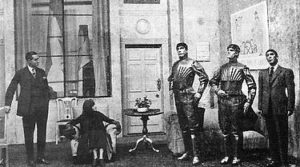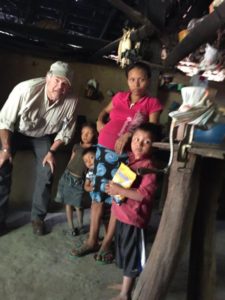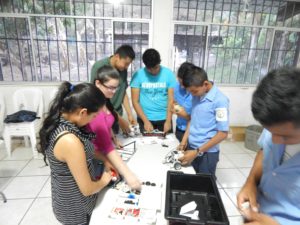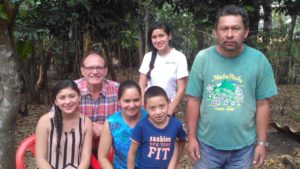You might think robots are a fairly new invention. Oddly, on January 25 of this year, they celebrated 96 years of imaginative and real existence when they first debuted on a Prague stage in Karel Capek’s controversial Sci-Fi play R. U. R. (Rossumovi Univerzáini Roboti – Rossumov’s Universal Robots). Robots seem to fascinate human thought, ambition, and dreams. If you’re close to my age, your first memory of robots may be of one simply named “Robot” who flung his arms up and down, teetering in exaggerated panic, and yelling out, “Danger, Will Robinson, Danger!” Beyond that, my Sci-Fi cultural formation has been underpinned by a series of robots: Rosie from the Jetsons, Rock-Em-Sock-Em robots, HAL, Optimus Prime, the adorable R2D2 and C-3PO, and WALL-E. Our fascination with robots may have something to do with their being created in our own image and designed to overcome the challenges of our finite nature. Though they often symbolize the tragic consequence of striving to be godlike as in the dark theme of Capek’s play, they also relate our sense of inner beauty and purpose. Somehow robots give expression to our capacity and drive to transcend the limitations of mortal existence. The Terminator, later Governator, says it best in his signature Austrian cyborg accent, “I’ll be back.”

Robots arrived on the Frontera of Intibucá last week. They came with a rather eclectic ambassadorial Shoulder to Shoulder team. Our board president, Wayne Waite, organized the trip of six individuals who had no knowledge of one another prior to the trip. They came with diverse purpose and hope. Paul and Sandy, a couple on the heels of retirement, came to explore and discern a possible long-term commitment to living in Honduras and volunteering with Shoulder to Shoulder’s ever evolving education mission. Ian, a fourth year business major at the University of Dayton, also came to discern long-term volunteering. Haley, a registered nurse from Oklahoma, came to begin her service with Shoulder to Shoulder working with brigades and the bilingual school. Tim Gunderman, a Knight of Malta USA, a seasoned gentleman whose heart is attached to service to the poor, came to see our nutritional supplement program in action in the hope of raising funds for its continuation and expansion. Not knowing one another and not sharing in any obvious purpose, how could this group come together with a unified vision? And what in the world does it have to do with robots?

Mr. Tim Gunderman has never been to the Frontera, though he’s familiar with Honduras. Driving along the washed out roads with our four-wheel vehicle, taking forty-five minutes to traverse a six mile distance while avoiding the cliffs, he turned to me and expressed his amazement. “Here?!, in this totally isolated, resourced challenged area where water runs only every other day for an hour and sometimes doesn’t run at all. Here?!, where the electricity, when it is not off, isn’t powerful enough to run a microwave. Here?!, where families of ten live on the sides of mountain cliffs in one room huts. Here?!, where the woman in the same house of ten boils hand-made soap on a stove inside the house without a chimney to exhaust the fumes. Here?!, where children are malnourished and at risk for chronic disease and death and we are not sure if we can find funding to continue their nutritional supplement. Here?!, this is where Shoulder to Shoulder is bringing first-class, computer technology, internet capacity, and robots in order to revolutionize a system of education and create development?” I thought briefly about his question, and then simply answered, “Yes.”

While Mr. Gunderman witnessed our nutrition program and the distribution of the supplement Chispuditos in the small towns of the Frontera with me and Wayne and filmed by Ian, Sandy and Paul with Laura worked on initiating the robot project. Sandy, a retired teacher, has worked with robotics competitions and the LEGO product Mindstorm. In fact she was able to bring the product with her and the teenagers will be working with it over the next months. Fourteen young people from Concepción and Camasca have been enrolled in the program and will work two hours daily on the project under the supervision of local instructors. Dionisio, 14, lives with his family in the small village of San Ignacio. He walks forty-five minutes to and from the high school every day over a mountain. He’s never been outside of Camasca. His father works the land for a living and is a leader in his church community. His mother takes care of her home and makes and sells pottery to augment their meager income. But Dionisio is on the team, he will commit himself to it with great passion, and hopes to be chosen to go to Washington, DC in July.
I can hear your questioning skepticism. Why? There is always that doubt and fear of technical advancement. If (insert preferred deity’s name here) wanted the human person to fly… But humans do have brains and hearts and they will ever consider the possibilities of transcendence. I’ll let you in on a little secret. This has nothing to do with robots. It has everything to do with Dionisio scaling that mountain every day. It has everything to do with seeing children suffering from nutrition and thinking, “My God, this cannot be allowed.” It has everything to do with six people who seemingly have nothing in common coming to Honduras on a trip and discovering a common goal of helping people to find dignity, worth, and well-being.

Why was I, and perhaps you as well, so fascinated with robots as a young boy. Why did Karel Capek write a play about them decades before they became reality? Could it simply be the unbounded nature of our imagination? Is the human person enslaved by limitations and mortality? Are we to be forever chained to the scorn and indignity of poverty? Can we move beyond it? I think perhaps robots are the expressions of the best we want to be. Moving beyond the possible, overcoming the obstacles in the way, is the only thing that has ever truly revealed the human soul. We are the designers of our destinies.